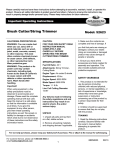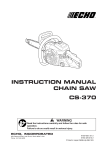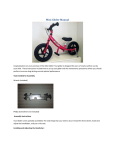Download t-rex 43cc gas powered scooter user manual
Transcript
T-REX 601A/W 43CC GAS POWERED SCOOTER USER MANUAL BOOK 1 Table of content Important Safety Precautions Quick Start Guide Brake Adjustment Guide Chain Adjustment Guide Carburetor Adjustment Guide Steering Column Adjustment Trouble Shooting Easy Step Installation 2 Important Safety Precautions Please operate your scooter with the following safety instructions. This scooter should only be ridden by persons with excellent vision, balance, coordination, reflex muscle tone, strength, and the good reaction to sudden incident. 1. Please read the manual and all safety notice carefully, understand its functions, maintenance and operating procedures completely before using the scooter. 2. Minor shall never operate this scooter without adult supervision. 3. Never operate your scooter on slick or unstable surfaces such as dampness or loss gravel, etc. 4. Never operate your scooter on public road, street, or highway. 5. Never operate your scooter without wearing proper safety equipments. 6. Never operate your scooter under influence of alcohol, drug or magnet. 7. Never attempt wheelies, jumps, or other stunts. 8. Never operate your scooter on steep hill or inclines. 9. Do not turn at excessive speeds. 10. Always inspect your scooter prior to each use to make sure it is in safe condition. Follow inspection and maintenance procedures in this manual. 11. Fuel is highly flammable. Keep it safe away from any source of fire. 12. Engine and muffler will get hot while using, don’t touch with hand. Quick Start Guide: Make sure that all cables are not binding and have good action. Check gas lines so they are not too close to any moving parts. Make sure handlebar hinge is secure. 1. Fill fuel tank with premixed two-stroke (cycle) oil in it. We recommend a ratio of 32 to 1. DO NOT use straight gas; engine will seize and can cause injury. 2. Prime the carburetor by pressing the bulb located on the bottom of the carburetor until all air bubbles and fuel flow back to the tank through the clear line. 3. Place the choke (the lever located on the side of the air filter) in the "OFF" (up ) position (this does not mean the choke is off, it means the engine is off - the choke is on in this position) 4. Pull the pull start to get the engine going. If this is your first or second time starting the scooter, it may take 10-20 pulls to start it. This will get much easier after the scooter is broken in. Do not yank on pull starter too hard. Short quick pulls will work fine; yanking too hard will break pull starter. 5. Once the scooter is started, let the engine idle for a minute, and then Flip the choke to the "ON" (lever down)position before the engine dies. 6. Give the engine a little throttle right after it starts to get it going. You may also have to give it a little bit of throttle while pulling the pull start, although this often not necessary. Press the kill button to stop the engine And now you're good to go! Once your scooter gets broken in, it won't be necessary to turn the choke on to start the scooter, and it won't take so many pulls to get it started. It does help to pump the bulb under the carburetor every time just to get the fuel flowing through it, since it dries up when it sits. 3 BRAKE ADJUSTMENT GUIDE Often the disc brakes on our gas scooters will require adjusting. Do each step below and check and see if the brakes are adjusted correctly after each step. There is no need to complete all the steps if only one or two adjustments fix them. Usually the first Step One: This usually fixes any problems. First turn the smaller hex bolt circled above using a 2.5mm hex wrench. There are two hex heads on this same screw circled above. The smaller 2.5mm one is hidden deep beneath the larger 5mm one. Step Two: Usually Step One fixes most problems, the next three steps help fine tune the brakes. Loosen the cable holder using a 5mm hex wrench. Then use some pliers to hold the cable, then move the arm towards the engine, and retighten the 5mm hex screw. Step Three: Turn the knob circled by hand as shown in the picture. Step Four: Turn the silver piece circled above by hand, then lock it in place by turning the black piece until it is closest to the hand lever just like in the picture above. 4 Chain Adjustment Guide Proper chain adjustment is important for performance and safety. If the chain is adjusted too tightly it will bind and prematurely wear the chain and cause reduced performance. If the chain is too loose it may jump teeth or fall off the sprocket. STEP ONE: Check the chain. See if there is some play in the chain or if it feels too tight. Check the top and bottom lengths and see if either one deflects 1/4 to 1/2 inch with light pressure. When you press on the chain it should deflect about 1/4 to 1/2 of an inch. Check both lengths of the chain. We have found that most of the scooters arrive with the chain too tight. STEP TWO: If adjustment is needed, loosen the bolt and nut securing the band brake to the frame. Just back it off a bit so it isn't too tight. STEP THREE: Loosen the large nuts securing the rear axle. Loosen both sides just a little--maybe one or two turns. STEP FOUR: Use the chain adjusters to move the wheel back to tighten or forward to loosen the chain. To use the adjusters, loosen the outer nut and then turn the inner nut to the desire position then tighten the outer nut back up against the inner nut to lock it in place. STEP FIVE: Tighten everything back up and check the chain again. Don't forget to tighten the axle and band brake connection to the frame. 5 CARBURETORS ADJUSTMENT GUIDE Sometimes the carburetors aren't quite adjusted correctly from the factory. If your scooter isn't quite going as fast as it should, or it won't idle, then you probably need to adjust your carburetor. It's easy to adjust one. Just follow these steps: Step One: Remove the air filter cover. This is the black box located on the left side of the scooter, towards the front of the engine. There is a screw right in the middle to unscrew. Step Two: You should now be able to see the air filter and behind it the carburetor. There are two screws on the carburetor which you can adjust, the air screw and the idle screw (see picture to right for guide). The small gold screw on the side of the carburetor is the idle speed screw. This screw controls the idle speed; the tip should extend about a 1/8 of an inch (4 mm). Adjust it so the engine will idle at just fast enough speed to stay running. The black screw located lower on the side of the carburetor next to the choke lever is for the high speed mixture. Step Three: Usually the idle screw doesn't need any adjustment. What usually needs adjustment is the air screw. We've found screwing it all the way in, and then out 3 1/2 turns is usually the right setting. Start by turning this screw in (clockwise) until it stops. Don't turn it in tight, just until it stops. Next, turn the screw out two full turns (counter-clockwise). This is the factory setting. You should be able to start and operate the scooter with this setting. Once you have it running, you can fine tune. You should try putting the scooter up on a brick or chair, and then giving it throttle after you adjust it. It's adjusted optimally when the engine is making the highest pitched noise. Step Four: There is also a main jet adjustment screw dead center on the top of the carburetor. This is most always set at 1 full turn out. If this is not adjusted correctly, your scooter may not run, or run very poorly. Once again, turn screw all the way in (clockwise) and then out (counterclockwise) 360 degrees (1 full turn). 6 Steering Column Adjustment: To tighten: Loosen small set screw on top nut, take big crescent wrench and turn nut clockwise. Be careful not to over tighten. Lift the front of the scooter off the ground. Push the handle bar in one direction or the other. It should swing freely. If it just stops and doesn't swing in one direction then back again it is too tight. To see if it is to lose: Kneel in front of scooter, pick up front end of scooter by the fork with one hand, grab the steering column below the release post with the other hand and rock back and forth. You should not feel any play, if you do tighten as instructed above. Gasoline / Oil Mixture Tire pressure Spark Plug Gap Synthetic oils are the best to use in your scooter, along with a standard grade octane pump gas. A word on engine oil: 32: 1 is the recommended mixture ratio. This ratio is dependant on the quality of 2-cycle premix oil used. TIP: If using a high-quality synthetic oil such as Maxima Castor 927 mix at 32:1 ratio for best performance. 30 to 35 PSI The rear tire tube valve is a little tricky to get to. The easiest method is to pull the valve over with a screwdriver and then thread on a valve extension (available at any auto parts store). Adjust air pressure as necessary and then remove valve extension. 024-.028 inches (.60-.70 mm) 7 I'm having trouble starting my gas powered scooter. What is the best way to start it? On my scooter when I'm riding it a lot of the time the chain just falls off. How do I fix it? What's the purpose of the small plastic tube that says 40ml on it that comes with the gas powered scooter? How do I mix the gas and oil? How much oil do I put in? Please read our starting guide first. If it still won't start, you may need to adjust your carburetor. Please read the section ‘adjust you carburetor” for details. It's usually very easy to fix. There are two reasons it can happen: 1. If it happened when you were accelerating it usually happens because the front and rear sprocket are misaligned. To fix it you need to remove the engine from the engine mount, then adjust the engine mount (it can slide once you loosen the bolts) to get the sprockets in better alignment. This can be done by loosening the three bolts on the bottom of the engine. The idea is to get the front and rear sprockets aligned in a straight line. 2. Otherwise you might need to tighten the chain, but usually the problem is #1. See “Chain Adjustment Guide”. 40ml is how much two-stroke oil you need to mix with 1 liter of gas. Please check your scooter's fuel tank size. This might be how much oil you need for a full tank. It is usually easier to get a gas tank that holds a gallon or two and dedicate that to your two-stroke engine. Then you'll always have gas/oil mixed and ready. Most of our scooters come with a 1 liter tank, which means it's just 40ml (one canister) of 2stroke oil per tank of gas. Regardless of your tank size, these instructions will work: You fill a gas tank with one or two gallons and leave a little room for oil, then dump in the right amount of oil and slosh it around to mix it. Some oils don't require as much as others for proper lubrication. Follow what the oil bottle directions instruct for mixing. Here is the basic mixing formula for a gallon. Here's how you do the math: There are 128 oz of gas in a gallon. 1/25th of that would be: 1/25*128 = 5.12 oz of oil needed. 8 The disc is straight but the brake assembly is not. The front brake is straight and works. Also the cable pulls the lever and it hits the engine. We tried adjusting the cable with no results. I filled gas, pressed the bulb. Then I keep the thing off and pull start and it does not start. What is wrong? When pull to start engine, it pulls out but engine does not turn over. Two or three tries and it engage and engine turns over or starts. What kind of maintenances should I perform on my scooter? What are the two tubes coming from the gas tank to the carburetor? What kind of gas do I need to put in a gas powered scooter? Does the gas powered scooter require any lubrication of the transmission? Try using the large adjustment cylinder... it is silver... should fix the problem. Please be sure that the two tubes from gas tank installed to the right nipples under the engine. The right order is that the black one goes on the curved nipple and the clear goes on the straight. If it still does not start, pump the primer bulb 10 times and put the choke in the up position and give it 5-7 quick short pulls. It should start, if not, give little throttle while pulling rope. There is a problem with starter pawl. If your scooter is still under the warranty, contact the distributor for the replacement parts. There is one maintenance check which is very important. Make sure all of the bolts are tightened before you go out riding. These scooters vibrate quite a bit, which causes the bolts to come loose. Specifically, check the front axel bots, the engine mounts (located right beneath the engine), the gas tank screws, the front fender screw (if your scooter has a front fender), and the deck screws. Also make sure the handlebar folding mechanism is good and tight. You should also oil the chain once in a while (not very often). 3-in-1 oil works great for that. There are two tubes: one from the tank to the carburetor and one going the other way. The clear tube is the fuel return; The black tube is the fuel supply. The black one goes on the curved nipple and the clear goes on the straight one. 32 to 1 is the ratio recommended. Doesn't matter what kinds of unleaded gas but make sure you use two-stroke oil? The 90 weight gear oil in the transmission should not need changing for the life of the gas powered scooter. 9 Thanks for buying one of these great T-REX scooters! There are 10 easy steps to putting your scooter together. Please read the instruction carefully before you start riding scooter. Easy Step Installation 1. Unpack the scooter by opening the top of the box and remove the loose parts at the top. Remove the Styrofoam holding the front wheel by tipping it back toward the rear of the scooter while you hold the handle-bar post. Then remove the rear Styrofoam. 2. Find your tools and attach the steering column to its hinge. Don't make it too tight for now but later you might want to tighten this if the column is too loose. 13mm and 14mm wrenches required. See “Steering Adjustment Guide”. 3. Lock the steering column in place by rotating the locking bolt up and then turning the nut clockwise. It works just like the one on a typical bicycle seat post. 10 4. Attach the handlebar ends with the thumb screws. See the photo so you put the right end on the right side. Note: The front axle is pointing backwards as packed. 5. Attach seat post and seat. Insert the seat post fully into the sleeve until it hits the bottom, then tighten the strap. Remove the scooter from the box by lifting the seat post and handlebars. Turn handlebars forward and lay the scooter on its right side (side opposite the engine).5mm hex wrench needed. 7. Put the kickstand down and bring the scooter upright. Attach the gas tank with the two hex bolts. Slide the hose springs closer to the gas tank and route the hoses so that they aren't in the way of any moving parts (chain, wheel, etc.). Also make sure they are not pinched. 8mm hex wrench needed. 8. Adjust the brakes by tightening the adjustments at both ends of the brake cable until the wheel still rolls but the brake works well. See the “Brake Adjustment Guide” 9. Adjust chain. See the “Chain Adjustment Guide” 10. Adjust Carburetor if needed. See the “ Carburetor Adjustment Guide” 11 SEA BEYOND INT’L INC LOS ANGELES, CALIFORNIA UNITED STATES OF AMERICA 12























